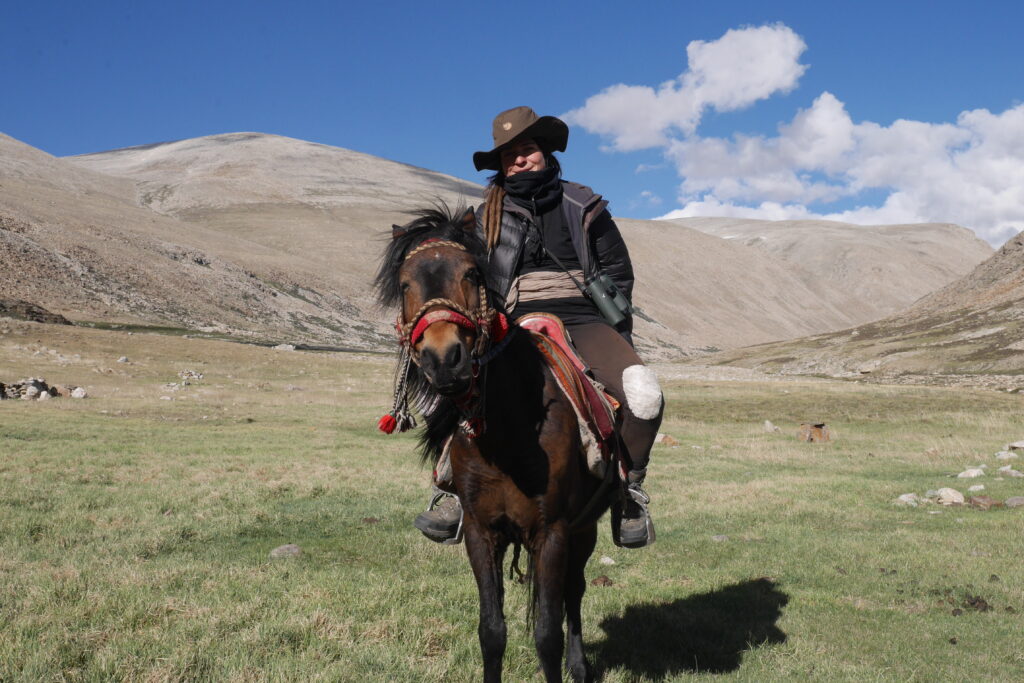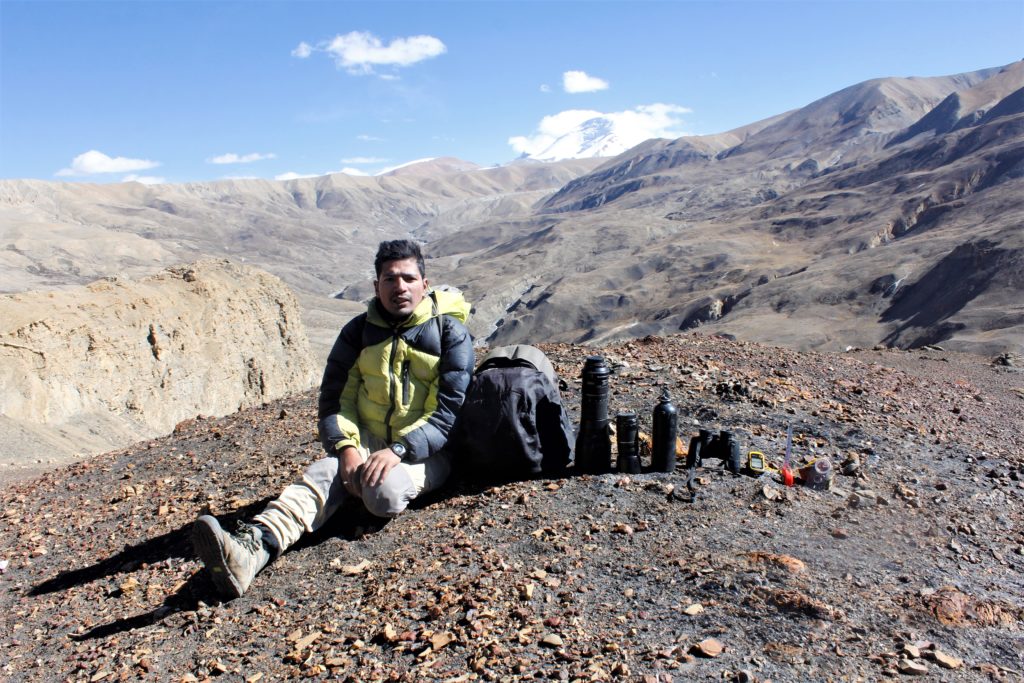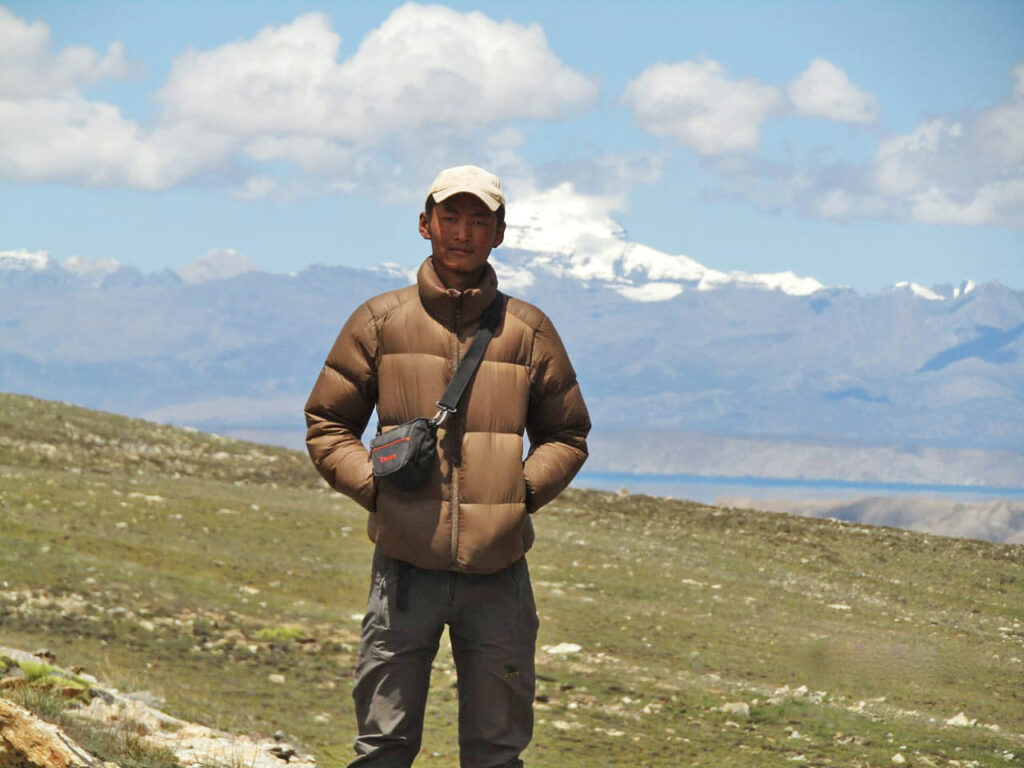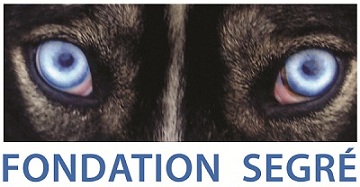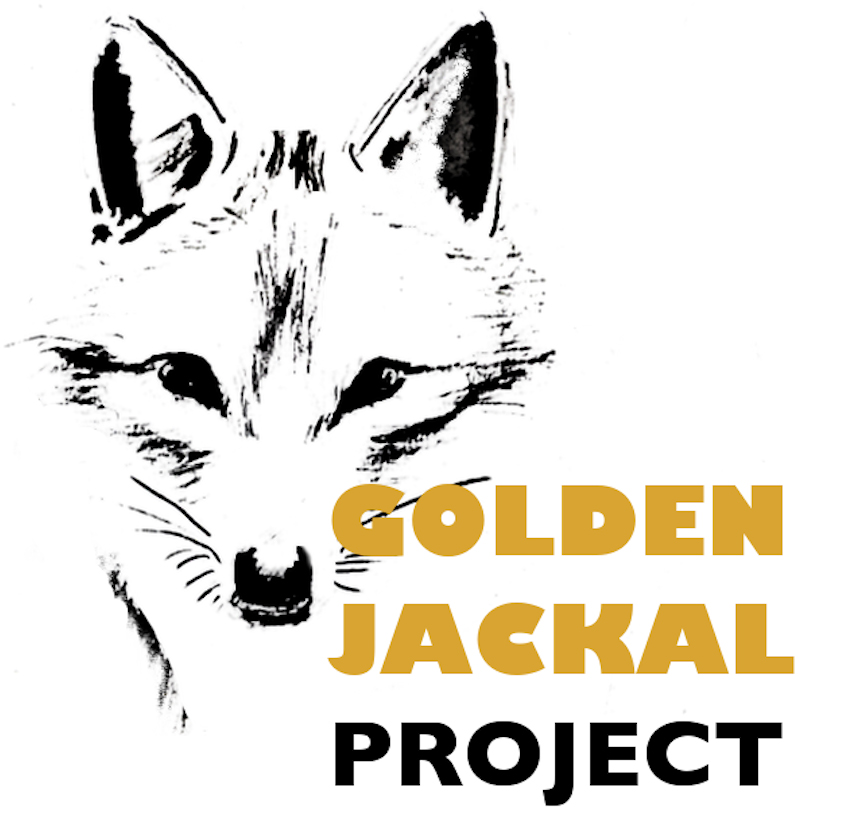‘Dedicated to keep the wild things in the wild and conserve the nature spaces they inhabit.’
Geraldine Werhahn (HWP Director) is a wildlife biologist and conservationist dedicated to every element of the natural world. Her special interests are carnivores and their function in maintaining healthy ecosystems, their intelligence, and their power to trigger human emotions in all cultures. She recently completed her DPhil thesis on the phylogeny, ecology, and conservation of Himalayan wolves with WildCRU at the University of Oxford, UK. As a wildlife biologist she aims to provide solid science as an argument for conservation, and as a human animal she lives the love for nature by a compassionate way of life.
Curriculum Vitae in brief
- Conservation research around Himalayan wolves and their ecosystem 2020-present
- Deputy Chair of the IUCN SSC Canid Specialist Group (CSG) Mai 2020-present
- DPhil research on the Phylogeny, ecology, and conservation of Himalayan wolves WildCRU, University of Oxford, 2016-2020
- Research on the wolves in the Himalayas 2013 – 2015
- Intraspecific gaze following among wolves (Canis lupus) and dogs (Canis familiaris) – A comparative investigation of two canid species Wolf Science Center Austria, 2012
- Montana wolf population monitoring Montana Fish Wildlife and Parks USA, Summer 2011
- Systematic monitoring of the lynx population in Switzerland by means of capture-recapture analysis KORA Switzerland, Winter 2010/2011
- Master in Wildlife Ecology ETH Swiss Federal Institute of Technology Switzerland, 2010
- Bachelor in Biology ETH Swiss Federal Institute of Technology Switzerland, 2008
Naresh Kusi (HWP Country Programme Director) is a young wildlife biologist and an explorer with a special affinity towards the carnivores of the Himalayas. He has a M.Sc. in Environmental Science (Biodiversity Conservation and Wildlife Management) from Tribhuvan University, Nepal and a PGD in International Wildlife Conservation Practice from WildCRU, University of Oxford, UK. A recipient of Young Conservation Leader Award (National Conservation Day 2016, Nepal), he is keen towards finding appropriate ways to ensure an effective coexistence between the wild carnivores and people in the Himalayas.
Sabita Gurung (Project Officer, HWP) is a wildlife biologist born in an indigenous Gurung community of Ghanpokhara in Annapurna Conservation Area, Nepal. She has an M.Sc. in Zoology (Ecology and Environment) from Tribhuvan University, Nepal, and a PGD in International Wildlife Conservation Practice from WildCRU, University of Oxford, UK. Her special interest is in studying predator-prey dynamics, human-wildlife conflict, and human dimensions in nature conservation and sustainable co-existence.
Pema Rikjin Lama (Local Field Officer, Camp Manager and Cook at the HWP) is a native of Limatang village in Nyin Valley, Humla, Nepal. Pema is the soul of our research expeditions. He cooks, manages the camp and always keeps his eyes open for interesting wildlife observations. He also plays a crucial role in our conservation endeavors as a moderator as well as a local translator.
Antonio Sampedro (PhD student) is a wildlife biologist. He is a biologist specializing in Animal Biology, he is currently pursuing a PhD student at the University of Oviedo, Spain. He has been a Tibetan language translator for more than a decade and has been linked to Tibetan-Himalayan culture ever since. His main research interest is the habitat suitability and occupancy modelling of Himalayan wolf’s distribution, global warming and conservation actions through mitigation of human-wildlife conflict.
Dorjee Tundup Lama is a native of Til village in Limi Valley, Upper Humla, Nepal. He is an active member of the Community Conservation Group of Til village and a valuable local resource person for our conservation and research work on the ground. He plays an important role in our field research by coordinating the monitoring of our camera traps around the year.
Publication List
- Werhahn G. (2020) DPhil Thesis Geraldine Werhahn
- Werhahn G., Liu Y., Yao M.,……. and Senn H. (2020) Himalayan wolf distribution and admixture based on multiple genetic markers in Journal of Biogeography
- Werhahn G., Kusi N., Li X., Chen C., Zhi L., Lázaro Martín R., Sillero-Zubiri C., and Macdonald D. W. (2019) Himalayan wolf foraging ecology and the importance of wild prey. https://doi.org/10.1016/j.gecco.2019.e00780
- Macdonald D. W., Campbell L. A. D. , Kamler J. F., Marino J., Werhahn G., and Sillero-Zubiri C. (2019) Monogamy: Cause, Consequence, or Corollary of Success in Wild Canids? Frontiers in Ecology and Evolution. https://doi.org/10.3389/fevo.2019.00341
- Werhahn, G., Senn, H., Ghazali, M., Karmacharya, D., Sherchan, A.M., Joshi, J., Kusi, N., López-Bao, J.V., Rosen, T., Kachel, S., Sillero-Zubiri, C. & Macdonald, D.W. (2018) The unique genetic adaptation of the Himalayan wolf to high-altitudes and consequences for conservation. Global Ecology and Conservation. https://doi.org/10.1016/j.gecco.2018.e00455
- Werhahn G, Kusi N, Sillero-Zubiri C, Macdonald DW. (2017) Conservation implications for the Himalayan wolf Canis (lupus) himalayensis based on observations of packs and home sites in Nepal. Oryx
- Werhahn G, Senn H, Kaden J, Joshi J, Bhattarai S, Kusi N, Sillero-Zubiri C, Macdonald DW. (2017). Phylogenetic evidence for the ancient Himalayan wolf: towards a clarification of its taxonomic status based on genetic sampling from western Nepal. Royal Society Open Science. 4: 170186. http://dx.doi.org/10.1098/rsos.170186
- Werhahn G., Kusi N., Karmarcharya D., Sherchan A.M., Manandhar P., Manandhar S., Bhatta T.R., Joshi J., Bhattarai S., Sharma A.N., Kaden J., Ghazali M. & Senn H. (2018) Eurasian lynx and Pallas’s cat in Dolpa district of Nepal: genetics, distribution and diet. CATnews 67. Pp 34-36.
- Kusi, N., Manandhar, P., Subba, S.A., Thapa, K., Thapa, K., Shrestha, B., Pradhan, N.M.B., Dhakal, M., Aryal, N. & Werhahn, G. (2018). Shadowed by the ghost: the Eurasian lynx in Nepal. CATnews 68. 16-19 pp.
- Kusi, N., Acharya, R., Ghimirey, Y., Adhikary, B. & Werhahn, G. (2018) An update on the Tibetan argali Ovis ammon hodgsoni in Nepal. Mammalia. https://doi.org/10.1515/mammalia-2017-0167
- Werhahn G., Kusi N., Man Sherchan A., Karmacharya D., Senn H. (2016). Distribution update for Tibetan fox in western Nepal. Canid Biology & Conservation.
- Kusi, N. & Werhahn, G. (2016) HUMLA-Journey into the hidden Shangri-la. Himalayan Map House, Kathmandu, Nepal. 128 pp (Book)
- Kusi, N., Subba, S.A. & Shah, K.B. (2017) Prey for the ghosts. In Tracking the mountain ghost. WWF Nepal. pp: 44-50 (Book chapter)
- Kusi, N. 2018. The God in disguise. Resources Himalaya Foundation, Nepal, The Rufford Foundation, UK and WWF Nepal (Fable)
- Kusi, N. 2018. The helpful dong. Resources Himalaya Foundation, Nepal, The Rufford Foundation, UK and WWF Nepal (Fable)
- Kusi, N., Werhahn, G. and Poudyal, L.P. (2018) Birds of Dolpa: Shey-Phoksundo National Park and Adjoining Areas. Nepalese Ornithological Union and Department of National Parks and Wildlife Conservation, Kathmandu, Nepal. (Book)
- Kusi, N. & Werhahn, G. (2018) The first breeding record of Common Redshank Tringa totanus for Nepal. Indian BIRDS Vol. 14 No. 2. Pp 56.
- Kusi N., Lama T. L, Lama P. R. and Werhahn G. (2017). The first record of Rufous-tailed Rock Thrush Monticola saxatilis for Nepal. Birding Asia 27: 116-124.
- Kusi N. & Werhahn G. (2016) The first documented record of Tibetan Lark Melanocorypha maxima for Nepal. Birding Asia.
- Werhahn G., Acharya R., Ghimirey Y., Kusi N., Adhikary D., Kunwar B. (2015). The Ungulate Community of upper Humla, North-Western Nepal. Gnusletter, Vol 32. N°2.
- Acharya R., Ghimirey Y., Werhahn G., Kusi N., Adhikary B., Kunwar B. (2015). Wild yak Bos mutus in Nepal: rediscovery of a flagship species. Mammalia.
- Appel A., Werhahn G., , Acharya R., Ghimirey Y., Adhikary B. (2013). Small carnivores in the Annapurna Conservation Area, Nepal. Vertebrate Zoology.
- Ghimirey Y., Acharya R., Adhikary B., Werhahn G., Appel A. (2013). Clouded Leopard (Neofelis nebulosa) camera trapped in the Annapurna Conservation Area, Nepal. IUCN/SSC Cat Specialist Group-Cat News N°58.
- Kusi, N. & Aryal, M. (2016) Livestock depredation and human casualties by leopard Panthera pardus in Bhaktapur. Journal of Environment Science, Vol 2. Department of Environment. Kathmandu, Nepal. 135-141 pp.
- Thapa, S., Katuwal, H.B., Gurung, R., Kusi, N., Devkota, B., Shrestha, B., & Suwal, T.L. (2018) Pikas in Nepal. Small Mammals Conservation and Research Foundation, Kathmandu, Nepal, x+51pp.
- Werhahn G., Virányi Z., Barrera G., Sommese A., Range F. (2016). Wolves (Canis lupus) and dogs (Canis familiaris) differ in following human gaze but respond similar to their packmates’ gaze. Journal of Comparative Psychology.
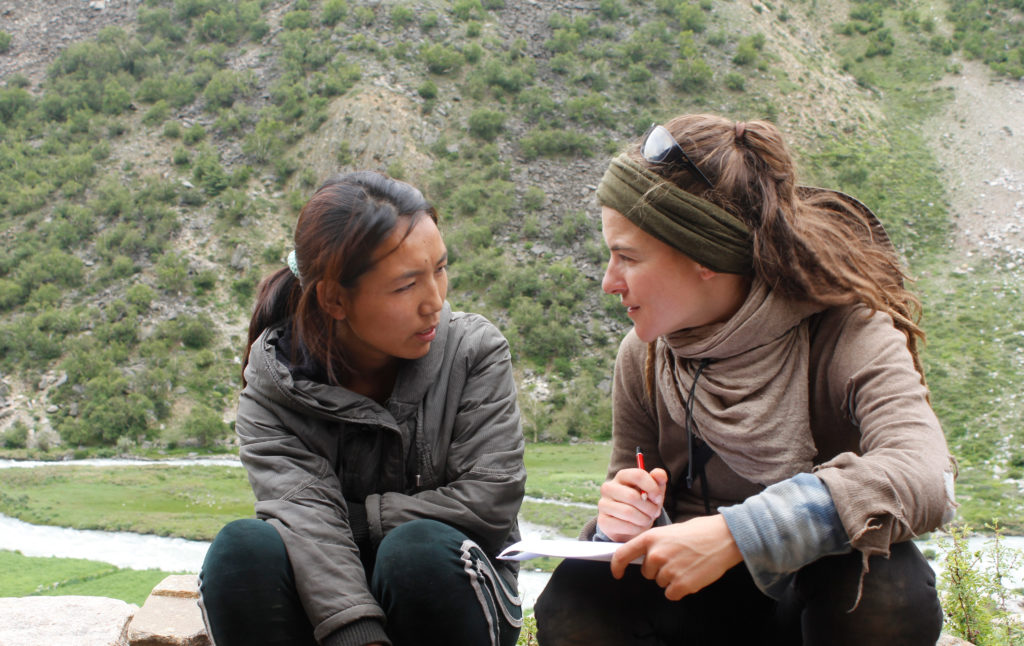
Social survey with a school teacher to explore human-wolf interactions (Photo courtesy Naresh Kusi).
Collaborators and Supporters
Partner projects
